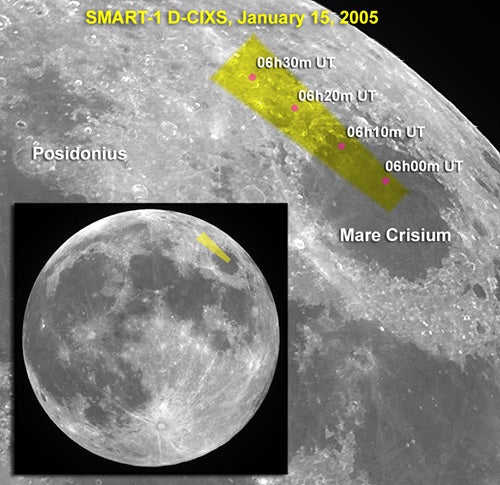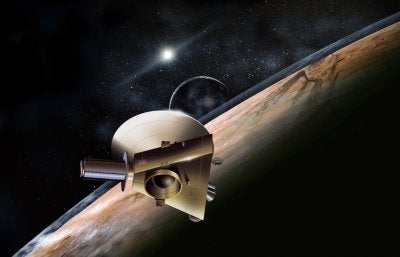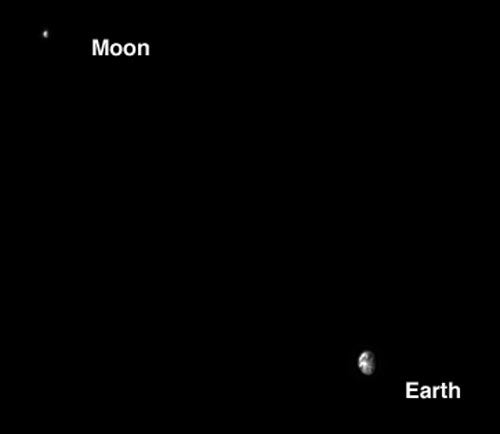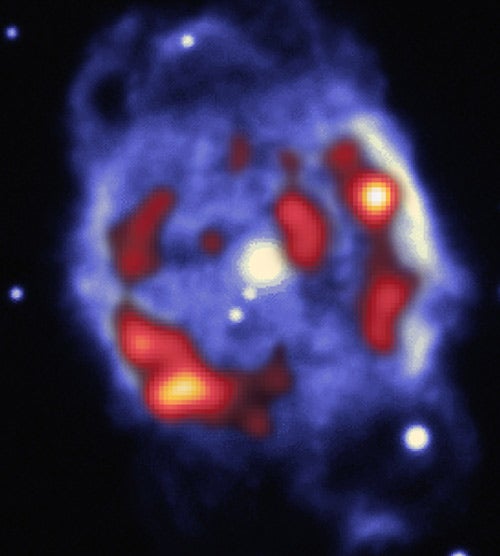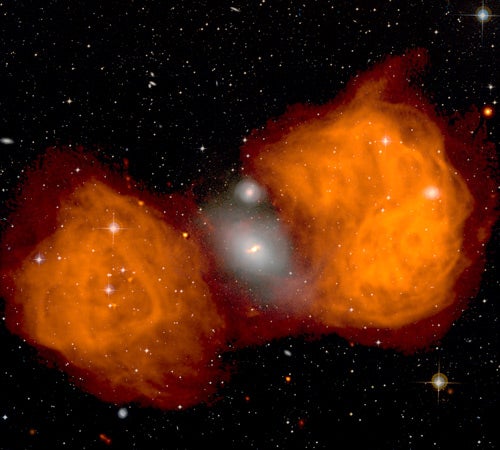The future of observing technology is here
On June 22, Corning Inc. announced it had completed the sagging process of a 4.2-meter mirror blank. The blank will be the primary mirror for Lowell Observatory’s new Discovery Channel Telescope. The mirror’s glass material, a Corning innovation, exhibits virtually no dimensional changes during extreme temperatures. Any distortions to a telescope’s optics can damage observing clarity and precision. The new material prevents any such distortion, ensuring crystal clear views of deep space.
The innovative material is just one facet of the cutting-edge technology found in the Discovery Channel Telescope (DCT). Lowell Observatory in Flagstaff, Arizona, is working with Discovery Communications to develop the new telescope. The DCT will support research of Lowell’s astronomers and provide programming opportunities for Discovery. When completed, DCT will be the fifth largest telescope in the continental United States. The telescope has an optical configuration that allows it to focus on a wide field or to be switched to a longer focal length — no other telescope in this class has this capability.
Construction on the telescope is projected to be completed in 2009.
For more on Lowell Observatory or the Discovery Channel Telescope, read “A visit to Mars Hill” in the June 2004 Astronomy. — Matt Quandt
Solar flash elucidates lunar elements
On January 15, as scientists ran the European Space Agency’s (ESA) SMART-1 lunar orbiter through steps to calibrate its instruments, an intense solar flare blasted X rays across the solar system.
When the X-ray torrent struck the Moon, surface rocks glowed in X-ray wavelengths characteristic of the elements making them up. As SMART-1 flew northward over Mare Crisium, the Sun’s X-ray flash helped D-CIXS distinguish calcium, aluminum, silicon, iron, and other elements on the lunar surface. “It is the first time ever that calcium has been unambiguously detected on the Moon by remote-sensing instrumentation,” says Grande.
Bernard Foing, ESA project scientist for SMART-1, is enthusiastic about the unexpected early data. “When we get D-CIXS and the other instruments fully tuned, with scientific data rolling in routinely, we should have a truly ground-breaking mission,” he says.
SMART-1, the first of ESA’s Small Missions for Advanced Research in Technology program, reached lunar orbit November 15, 2004, and comes as close as 280 miles (450 kilometers) to the surface. The spacecraft, which used a xenon-fueled, sustained-thrust ion engine and lunar resonances to extend its orbit to the Moon gradually, arrived nearly 14 months after launch. — Francis Reddy
Next stop for New Horizons: Greenbelt, Maryland
The New Horizons team shipped the probe from the Johns Hopkins University Applied Physics Laboratory (APL) in Laurel, Maryland, to NASA’s Goddard Space Flight Center in Greenbelt. Here, the first spacecraft designed to study Pluto will undergo pre-launch tests.
“Our testing program is off to a good start,” says New Horizons project manager Glen Fountain. “[At APL] we’ve shown that New Horizons is structurally ready for the ride on the launch vehicle, and now we’ll test it in the full range of conditions it would face on the voyage to Pluto, Pluto’s moon, Charon, and beyond.”
Tests for New Horizons will continue for 3 months at Goddard while the team examines its launch durability and adaptability to space conditions. After this battery, the spacecraft will move to Kennedy Space Center, Florida, for final launch preparations. — Jeremy McGovern
New director appointed for the Space Telescope Science Institute
In September 2005, Mattias Mountain will replace Steven Beckwith as director of the Space Telescope Science Institute (STScI) in Baltimore. Mountain will operate the science operations center for NASA’s Hubble Space Telescope and the planned James Webb Space Telescope (JWST).
Mountain has served as director of the Gemini Observatory, which runs two 8-meter Gemini Telescopes one atop Mauna Kea, Hawaii, and one at Cerro Pachon, Chile. He is not foreign to STScI operations – he also is a telescope scientist for JWST and a member of the impending space telescope’s science working group.
“It’s an extraordinary privilege to be asked to lead such a fascinating, diverse and challenging organization as the Space Telescope Science Institute,” says Mountain. “I’m looking forward to working with the superb Institute staff, NASA, and the astronomical community – the potential of what we can collectively achieve with HST and the James Webb is tremendously exciting.” — Jeremy McGovern
AGU to United States: Don’t sacrifice future of Earth and space science
The American Geophysical Union (AGU) has released a statement calling on the United States government and NASA to renew their dedication to Earth and space science programs. The declaration criticizes drastic 2006 budget cuts that will force NASA to do more with fewer resources.
The statement claims shifting financial responsibilities away from NASA programs will obstruct the effectiveness and potential of these programs and ultimately hamper the United States’ role as a leader in Earth and space sciences.
The AGU cites cancelled and postponed Earth System Pathfinder missions and Explorer-class satellites as examples of budget sacrifices hurting space science. The AGU believes “these losses will degrade our weather forecasting, search and rescue, and life and property protection capabilities. They affect our ability to understand natural hazards, map changes in Earth’s surface, forecast space weather, understand Earth-Sun connections, and explore the solar system.”
The AGU is an international science community that promotes understanding of and research in Earth and space science. To read the full statement, click here.
— Jeremy McGovern
James Webb Space Telescope under attack
According to The Baltimore Sun, the future of the James Webb Space Telescope (JWST) is in jeopardy. With costs that eventually may reach more than 28 percent over its $3.5 billion budget, JWST could be scaled back — or not launched at all.
Unexpected expenses and instrument changes have inflated the cost of the space telescope. Adding to the woes are disputes over how JWST will be launched and new rigid accounting practices.
NASA inquired if decreasing Webb’s mirror size and onboard instruments could lessen costs. Project scientists believe any reduction in JWST’s ability will dramatically decrease the telescope’s usefulness. Many fear the space telescope’s increasing roadblocks may lead to the entire mission’s cancellation.
Combined with the impending death of the Hubble Space Telescope, a scrapped JWST would translate into job loss for hundreds of scientists and engineers at the Goddard Space Flight Center in Greenbelt, Maryland, and Space Telescope Science Institute in Baltimore.
Originally called the Next Generation Space Telescope, JWST naturally has been viewed by the public as Hubble’s successor. But that idea is misleading — JWST has more in common with the current Spitzer Space Telescope. Spitzer observes the universe in the infrared part of the electromagnetic spectrum, just as JWST will. The Webb telescope will cover the wavelength region from 0.6 to 28 micrometers, or from the red end of the visible spectrum well out into the infrared. It will be optimized for observations in the 1 to 5 micrometer range. — Jeremy McGovern
MESSENGER spies Big Blue Marble
Nearly 3 months prior to its Earth flyby, NASA’s MESSENGER spacecraft imaged our planet. The craft, which launched from Cape Canaveral, Florida, in August 2004, will use Earth this August to catapult itself toward the inner solar system.
Testing its imaging system on May 11, MESSENGER captured 6 pictures of Earth. Taken from a distance of 18.4 million miles (29.6 million kilometers) away, the images reveal a sunlight portion of the Western Hemisphere and the Moon.
MESSENGER, an acronym for MErcury Surface, Space ENvironment, GEochemistry, and Ranging, is the seventh mission of NASA’s Discovery program – missions used to enhance our understanding of the solar system with focused, high-quality, and low-cost planetary science investigations. The spacecraft is scheduled to orbit Mercury in June 2011, making it the first spacecraft to encounter the inner planet since Mariner 10 during the late 1970s.
MESSENGER will take more images as it nears Earth. In August 2005, the spacecraft will make its closet approach at 1,458 miles (2,347 km), making it visible to small-scope observers in Eastern Europe, Africa, and Asia. — Jeremy McGovern
Using NASA’s Chandra X-ray Observatory, Joel Kastner and Rodolpho Montez of the Rochester Institute of Technology and University of Rochester, respectively, imaged NGC 40, a planetary nebula containing a dying star in Cepheus. The duo’s research revealed previously ejected gas surrounding the star has become superheated to the point of emitting X rays. Mass ejections during the star’s death caused violent collisions that warmed the gas. By understanding the stages during stars violent death of stars, astronomers receive a sneak preview of what may occur closer to home.
“[Planetary nebulae] offer astronomers a forecast of what could happen to our own Sun about 5 billion years from now – when it finally exhausts the reservoir of hydrogen gas at its core that presently provides its source of nuclear power,” explains Kastner.
Kastner and Montez believe the superheated gas stage is a short period early in a planetary nebula’s life. — Jeremy McGovern
Worth 1,000 words
Fred Lo, director of the National Radio Astronomy Observatory (NRAO), thinks radio astronomy data can be made as visually compelling as images from the Spitzer and Hubble space telescopes. To make the point, the NRAO announced this week it was sponsoring an annual image contest offering a grand prize of $1,000.
The contest is part of a broader effort to make radio-astronomy data more widely available to educators and the public, which includes creation of an expanded image gallery on the NRAO web site. The observatory is also developing techniques to assist radio astronomers in making images, especially in combination with those taken at other wavelengths.
“While we want to encourage images that capture the imagination, we also want to emphasize that extra effort invested in enhanced imagery also will certainly pay off scientifically, by reveling subtleties and details that may have great significance for our understanding of astronomical objects,” says Lo. Contest details are available here . — Francis Reddy

